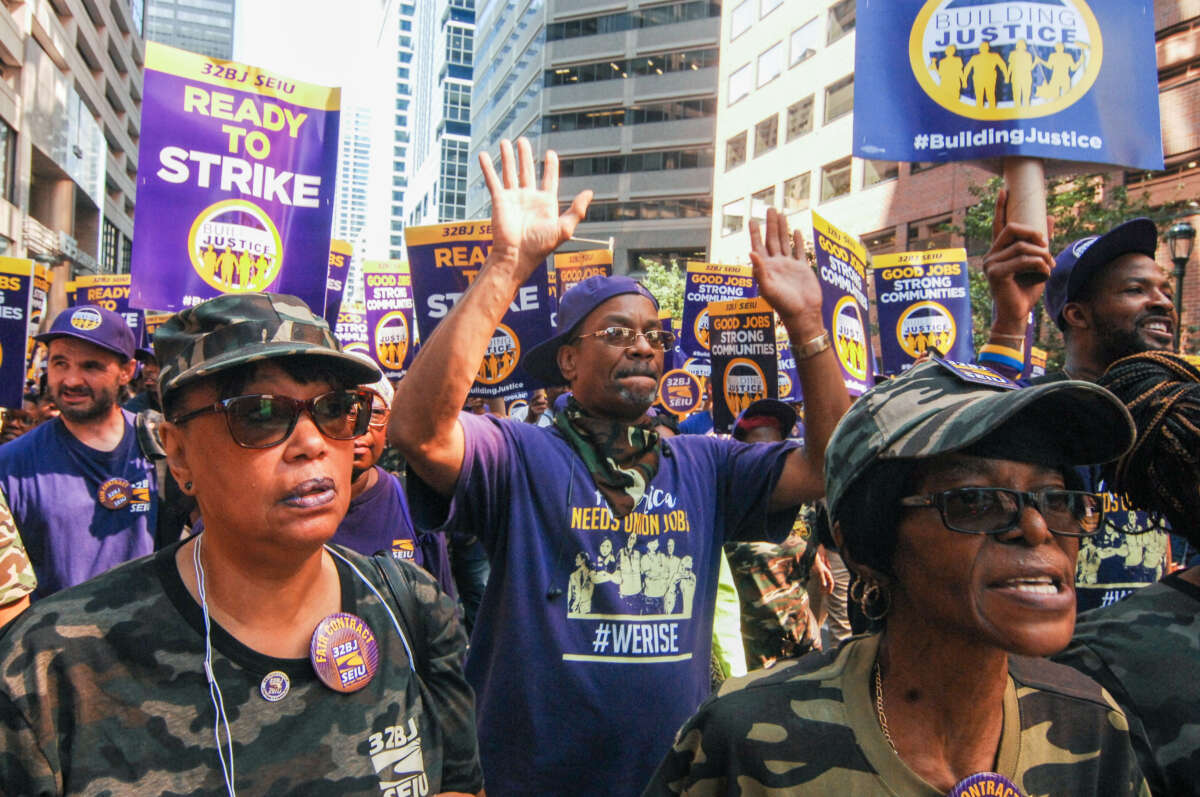Militant Black Unionism Offers Best Resistance to Growing White Nationalism
Organized Black labor combats the false barrier between racial and economic justice to achieve systemic change.

The United States economy keeps Black labor at the bottom because when bosses conceded on slavery, they settled on poverty wages. While white nationalism’s most visible soldiers are terror organizations and politicians, the quest for racial purity is , and other so-called job creators. Corporate benefactors fund extremist organizations like and The old Confederacy sought profit through a system of white apartheid. The new confederacy moves the same way through different means.
Yankee Institute is Heritage Foundation’s operation in Connecticut. Advertising as unbiased economic experts, somehow their expertise always seems to favor the elite. Their extremist political program hides behind Which taxpayers get the most opportunities won’t surprise you. Working families in Hartford, Connecticut, pay a higher percent on their income taxes than the richest of the rich down the road in Greenwich.
Tax cuts for the rich mean more wealth for Yankee Institute’s wealthy patrons. Lawmakers compromised by the elite deplete government revenue and open private markets that displace public services; or as the Yankee Institute would say, offer “limited government solutions.” Their mission is to destroy the public sector, and their goal is corporate dictatorship.
Yankee Institute’s line on markets mirrors many corporate Democrats. Our two business parties draw the line mostly according to class. The same rich donors work to elect both Democrats and Republicans loyal to capital. With exceptional privilege comes exceptional cluelessness, but some, , seem to genuinely believe in the merits of austerity. Blue dog democrats born into U.S. royalty, who can’t see Hartford from Greenwich, are allowing privatization to erode the general welfare.
Corporate lobbyists looking to cut public services find themselves with a problem: democracy. The question is how to cut a service when the public benefiting from it can vote. The new confederacy’s white conservative base usually gets outvoted by Connecticut’s broadly enfranchised multiracial majority, but even here, business politics still dominate, and business economics are the result.
Austerity dominates economically, but also ideologically; the goal being to turn the voting public against the public sector. Apparently new confederates know better than most Democrats about the correlation between funding and performance. Less funding makes public services less effective, and that’s exactly the point.
Austerity sets the fire, and gasoline fire extinguishers like “merit-based funding” do the rest. Despite what arsonists say, budget cuts on underfunded public institutions aren’t intended to make them succeed. After years of burning, people ask, what’s the point of a public service that isn’t serving the public? And then they vote.
That’s white capital’s way around democracy. Corporations dressed as politicians use their unprecedented wealth and power to make reality fit their lie. What follows is the public’s loss of support for its own institutions. Deftly executed white capitalist statecraft undermines the people’s will and bends it to the right.
The elite’s economic sabotage is more than that. It’s an attack on majority political power, particularly Black political power. Public sector decline weakens one of the most effective vehicles for racial and economic justice in this country: public sector unions.
The Power of Public Sector Black Labor
U.S. movements for multiracial democracy historically have Black leadership. Bishop William J. Barber leads an organization called the Poor People’s Campaign aimed at a Third Reconstruction. Their strategy starts with poor Black people and poor white people organizing to win democratic rights. It’s a strategy that’s led to victories like the 13th, 14th and 15th Amendments, and those were just a warm-up.
Like any army, our united front has primary fighting forces, recruited at the point of production. In the war against the new confederacy, our side relies on controlled chaos exercised through superior numbers. Poor, working- and middle-class people of all races make up the strategic alliance that can advance the united front furthest. The process of building multiracial democracy is Black-led class struggle.
Black and Brown state workers, according to a report from Steven C. Pitts, “are more likely to be in the top third of income, enabling them to anchor stable Black and Latino communities.” Higher public sector union density is a factor, but racial and economic uplift in the public sector is the outcome of successful fights, recent and historic.
Public sector agencies in the U.S. are the largest employers of Black workers. When organized, Black labor leads workplace fights that win higher standards, the whole working-class benefits. Pitts’s report on equity among Connecticut state workers, concludes that public sector unions are “the most effective organizations struggling for racial and gender parity in the workplace and the larger society.”
Organized Black labor was instrumental in the Second Reconstruction, including the civil rights movement of the ‘50s and ‘60s. mobilized to the 1963 March on Washington for Jobs and Freedom. Despite U.S. unions’ problem of mostly white leadership and history of discrimination, some supported Black civil rights struggles and even gave substantial resources. Unions engaged in militant racial justice fights using nonviolent direct action tactics. Workers leveraged their collective power at the point of production toward racial justice demands.
In 1969, nurses’ aides at an acute care hospital in Charleston, South Carolina, were organizing the Drug, Hospital, and Health Care Employees Union-District 1199B. Back then certified nursing assistants were called “nurses’ aides,” and like today, they were mostly Black and Brown women paid poverty wages.
The boss refused to recognize their union and fired several activists. If the workers wanted to win, it was time to escalate. . In the heart of the old Confederacy, these workers fought the false barrier between racial and economic justice.
They connected poverty wages to Southern white apartheid, understanding their fight as part of a broader Black freedom struggle. After months on the line, throats sore from chanting “Soul power!” and “I am somebody!” the boss agreed to raises, rehiring unjustly fired workers and a formal grievance process. When addressing a mass strike meeting, Coretta Scott King called the organized Black women workers “my favorite union.”
All the greatest economic progress in this country traces to organized Black workers leading multiracial fights for common good demands. Building Black-led worker organizations is a primary necessity for a Third Reconstruction program, and attacking Black organized labor is central to the new confederate strategy.
The super exploitation of Black labor is enforced through the subjugation of Black people, without which elite profit crumbles. Oppression deepens exploitation and devalues all labor relative to violently lowered standards. If Black labor is the essential basis of U.S. capitalism, it’s also the vanguard of its overthrow.
Southern slavery ended when war made abolition the only Northern option. President Abraham Lincoln only issued the Emancipation Proclamation after tens of thousands of Black workers had already freed themselves and shut down plantations. Crisis creates change.
Massive change takes massive crisis. Fighting creates situations for the enemy where meeting our demands seems better than letting the crisis continue. We only have one thing capable of sustaining a crisis on the scale of our vision. It’s our most powerful weapon, and it’s unlikely we’ll win expansion of the public sector without it.
Using the Strike and Ballot Weapons
Some public sector union organizers see a couple paths at least for generalizing the strike weapon. One is building statewide public sector union coalitions on a national scale to wage coordinated campaigns demanding the legal right to strike. Another focuses on building up the internal unity of public sector unions and emphasizing community support, so coordinated illegal strikes become winnable state by state.
The education sector, being one of the most experienced striking outside the law could offer valuable leadership in that. Since the backwardness of most public sector unions includes opposition to class struggle, any mass strike campaign will need militant progressive leadership. Defeating the right electorally is no less a priority, but nothing changes the terrain in our favor like the ability to shut down production.
A Third Reconstruction depends on lessons from the earlier two. Those attempts give us insight to fight and lead better on a federal scale. Our broad united front consists of everyone on the wrong side of the new confederacy, but without militant leadership, historically, progress is temporary.
The ballot in the hands of organized workers and poor people is a powerful weapon for progress. Electoral class struggle drove this country’s most politically progressive period when Black workers overthrew the slave system and exercised decisive governing power in the South. In 1870 and in 2023, expanding ballot access grows majority political power, which generalizes forward motion.
Sometimes after a hard fight, the ruling class retreats on democracy, but all the ground they’ve given up they’ve wanted back ever since. Our right to vote is a concession, not a guarantee. Defending progress puts us in constant battle. Every right we have started as a demand.
In 2011 the Supreme Court started eviscerating the Voting Rights Act. To balance the battlefield, a growing set of progressive forces have gone on offense. Some view the united front on a federal level as having stalled right-wing momentum, putting us in a partial stalemate with the new confederacy. Regardless, the struggle continues. Our enemy will never give an inch unless given no other choice. Everything they have is stolen. Everything we have is a victory.

No comments:
Post a Comment